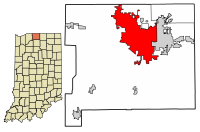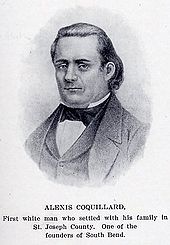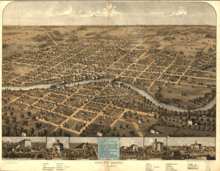
A | B | C | D | E | F | G | H | CH | I | J | K | L | M | N | O | P | Q | R | S | T | U | V | W | X | Y | Z | 0 | 1 | 2 | 3 | 4 | 5 | 6 | 7 | 8 | 9
South Bend | |
|---|---|
|
| |
| Nicknames: Lotion City, Wagon City, Metropolis of Northern Indiana[1] | |
| Motto: "Peace" | |
 Location of South Bend in St. Joseph County, Indiana | |
| Coordinates: 41°40′35″N 86°16′10″W / 41.67639°N 86.26944°W | |
| Country | |
| State | |
| County | St. Joseph |
| Incorporated (City) | 1865 |
| Founder | Alexis Coquillard |
| Government | |
| • Type | Strong Mayor-Council |
| • Body | South Bend Common Council |
| • Mayor | James Mueller (D) |
| Area | |
| • City | 42.40 sq mi (109.82 km2) |
| • Land | 41.98 sq mi (108.72 km2) |
| • Water | 0.43 sq mi (1.10 km2) |
| Elevation | 719 ft (219 m) |
| Population (2020) | |
| • City | |
| • Density | 2,464.57/sq mi (951.58/km2) |
| • Urban | |
| • Urban density | 1,885.5/sq mi (728.0/km2) |
| • Metro | |
| • CSA | |
| Time zone | UTC−5 (EST) |
| • Summer (DST) | UTC−4 (EDT) |
| ZIP Codes | 46601, 46604, 46612–46617, 46619–46620, 46624, 46626, 46628–46629, 46634–46635, 46637, 46660, 46680, 46699 |
| Area code | 574 |
| FIPS code | 18-71000 |
| GNIS feature ID | 2395913[4] |
| Demonyms | South Bender, Domer (Notre Dame) |
| GDP | |
| Website | www |
South Bend is a city in and the county seat of St. Joseph County, Indiana, United States,[6] on the St. Joseph River near its southernmost bend, from which it derives its name. At the 2020 census, the city had a total of 103,453 residents and is the fourth-largest city in Indiana. Located just south of the border with Michigan, South Bend anchors the Michiana region and is 72 miles (116 km) east of downtown Chicago. The metropolitan area had a population of 324,501 in 2020, while its combined statistical area had 812,199.[7]
The area was settled in the early 19th century by fur traders[8] and was established as a city in 1865. The St. Joseph River shaped South Bend's economy through the mid-20th century. River access assisted heavy industrial development such as that of the Studebaker Corporation, the Oliver Chilled Plow Company, and other large corporations.
The population of South Bend declined after 1960, when it peaked at 132,445. This was chiefly due to migration to suburban areas as well as the demise of Studebaker and other heavy industry. Today, the largest industries in South Bend are health care, education, small business, and tourism. Remaining large corporations based in the area include Crowe, Honeywell, and AM General. The city's economy and culture are influenced by the nearby University of Notre Dame.[9]
History
Early history
The St. Joseph Valley was long occupied by Native Americans. One of the earliest known groups to occupy what would later become northern Indiana was the Miami tribe. Later, the Potawatomi moved into the region, utilizing the rich food and natural resources found along the river. The Potawatomi occupied this region of Indiana until most of them were forcibly removed in the 1840s. The South Bend area was popular because its portage was the shortest overland route from the St. Joseph River to the Kankakee River.[10] This route was used for centuries, first by the Native Americans, then by French explorers, missionaries and traders.[11] The French explorer René-Robert Cavelier, Sieur de La Salle, the first white European to set foot in what is now South Bend,[12] used this portage between the St. Joseph River and the Kankakee River in December 1679.
First settlements
The first permanent white settlers of South Bend were fur traders who established trading posts in the area. In 1820, Pierre Frieschutz Navarre arrived, representing the American Fur Company (AFC) of John Jacob Astor. He settled near what is now downtown South Bend.[13] Alexis Coquillard, another agent of the AFC,[13][14] established a trading post known as the Big St. Joseph Station.[15] In 1827, Lathrop Minor Taylor established a post for Samuel Hanna and Company, in whose records the name St. Joseph's, Indiana was used.[14] By 1829, the town was growing, with Coquillard and Taylor emerging as leaders. They applied for a post office. Taylor was appointed postmaster, and the post office was designated as Southold, Allen County, Indiana.[13] The following year, the name was changed to South Bend, probably to ease confusion, as several other communities were named Southold at the time.
In 1831, South Bend was laid out as the county seat and as one of the four original townships of St. Joseph County with 128 residents.[16] That same year, Horatio Chapin moved to the settlement, opened the first general store with imported (out of state) goods and helped established the first church and Sunday school.[13] Around the same time, design began on what would become the town of South Bend. The town was formally established in 1835, with Chapin as the first president of the board of town trustees.[17] In 1856, attorney Andrew Anderson, Chapin's son-in-law, founded May Oberfell Lorber, the oldest continuous business in St. Joseph County.[18] He compiled a complete index of South Bend's real estate records.[19]

In 1841, Schuyler Colfax was appointed St. Joseph County deputy auditor. Colfax purchased the South Bend Free Press and then turned it into a pro-Whig newspaper, the St. Joseph Valley Register. He was a member of the state constitutional convention of 1850, at which he opposed the barring of African American migration to Indiana. He joined the Republican Party, like many Whigs of his day, and was elected to Congress in 1855, becoming Speaker of the House in 1863 during the administration of Abraham Lincoln. In 1868, he was elected vice president under Ulysses S. Grant. Colfax returned to South Bend after his stint in Washington and is buried in City Cemetery, west of downtown.[20]
Early business
During the late 1830s through the 1850s, much of South Bend's development centered on the industrial complex of factories located on the two races (man-made canals along the St. Joseph River in South Bend). Several dams were created and factories were built on each side of the river. On October 4, 1851, the first steam locomotive entered South Bend.[13] This shifted commerce from the river to the railroad. In 1852, Henry Studebaker set up Studebaker wagon shop, later becoming the world's largest wagon builder and the only one to later succeed as an automobile manufacturer. The Singer Sewing Company and the Oliver Chilled Plow Company were among other companies that made manufacturing the driving force in the South Bend economy until the mid-20th century.[13] Another important economic act was the dredging of the Kankakee River in 1884 to create farmland.[21] During this time period there was a great immigration of Europeans, such as Polish, Hungarian, Irish, German, Italian, and Swedish people to South Bend because of available employment in area factories.[22]

South Bend benefited from its location on the Michigan Road, the main north–south artery of northern Indiana in the 19th century.[13] Another significant development occurred near South Bend in 1842, when Father Edward Sorin founded the University of Notre Dame just north of the town.[23] It became a major factor in the area's economy and culture.[24]
Establishment and early history
South Bend was incorporated as a city on May 22, 1865, and its first elections were held on June 5, 1865, with William G. George elected as its first mayor[14] The official city motto, "Peace", refers to the fact that incorporation came in the month following the Confederate surrender that effectively ended the American Civil War.
Zdroj:https://en.wikipedia.org?pojem=South_Bend,_Indiana
Text je dostupný za podmienok Creative Commons Attribution/Share-Alike License 3.0 Unported; prípadne za ďalších podmienok. Podrobnejšie informácie nájdete na stránke Podmienky použitia.
Antropológia
Aplikované vedy
Bibliometria
Dejiny vedy
Encyklopédie
Filozofia vedy
Forenzné vedy
Humanitné vedy
Knižničná veda
Kryogenika
Kryptológia
Kulturológia
Literárna veda
Medzidisciplinárne oblasti
Metódy kvantitatívnej analýzy
Metavedy
Metodika
Text je dostupný za podmienok Creative
Commons Attribution/Share-Alike License 3.0 Unported; prípadne za ďalších
podmienok.
Podrobnejšie informácie nájdete na stránke Podmienky
použitia.
www.astronomia.sk | www.biologia.sk | www.botanika.sk | www.dejiny.sk | www.economy.sk | www.elektrotechnika.sk | www.estetika.sk | www.farmakologia.sk | www.filozofia.sk | Fyzika | www.futurologia.sk | www.genetika.sk | www.chemia.sk | www.lingvistika.sk | www.politologia.sk | www.psychologia.sk | www.sexuologia.sk | www.sociologia.sk | www.veda.sk I www.zoologia.sk









